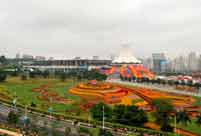The manufacturing PMI, which reflects factory production activity, rose to 51 in August from 50.3 in July, indicating the fastest expansion of the industry in 16 months.
A reading above 50 indicates activity in the sector is accelerating, while one below 50 points to a slowdown.
Li said China will be able to achieve long-term and healthy growth based on three basic factors.
These are huge potential for domestic demand in the industrialization and urbanization process; reform to eliminate obstacles in the government management system; and improvement in growth quality and efficiency based on increasing people's incomes and consumption.
"For the government, the top priority is to ensure sufficient employment," he said.
Li said the government will adopt a long-term, proactive employment policy, accelerate the service industry and promote occupational training to keep the labor market stable.
Chris Leung, a senior economist at DBS Bank in Singapore, said China is expected to maintain stable economic growth and achieve the 7.5 percent growth target set for this year, boosted by a series of positive economic figures for trade and inflation.
"The present macroeconomic environment is much different from the late-1990s, when conventional Keynesian and monetarist approaches could be applied aptly," said Leung, who added that he believes the policy taken by the Chinese government will neither over-stimulate the economy, nor allow it to sink further.
The country's economic growth slowed to 7.5 percent in the second quarter, down from 7.7 percent for the first. It was the ninth deceleration in the past 10 quarters.
Investors had feared the economy was slipping into a deeper-than-expected downturn, especially after the money market suffered an unprecedented cash crunch in June.
But the central government has introduced measures to stabilize the economy, including small-scale investment on railways and public housing construction and the launch of policies to help small companies in need of financing.


 DPRK holds military parade to mark 65th founding anniv.
DPRK holds military parade to mark 65th founding anniv. Highlights of MAKS 2013 Int'l Aviation and Space Show
Highlights of MAKS 2013 Int'l Aviation and Space Show  10th China-ASEAN Expo opens in Nanning
10th China-ASEAN Expo opens in Nanning Eagle Boy takes to sky to break another record
Eagle Boy takes to sky to break another record 12-year-old boy becomes pillar of the family
12-year-old boy becomes pillar of the family Eye-gouged boy receives blind rehabilitation in Shanxi
Eye-gouged boy receives blind rehabilitation in Shanxi Top 10 naked hotels in the world
Top 10 naked hotels in the world The most gorgeous Chinese women in the eyes of foreigners
The most gorgeous Chinese women in the eyes of foreigners A collection of bizarre rooftop buildings around China
A collection of bizarre rooftop buildings around China Residences of the royal house of Savoy
Residences of the royal house of Savoy China's frigate 'Bengbu'in fire training
China's frigate 'Bengbu'in fire training Fresh students 'forced' to register in university independently
Fresh students 'forced' to register in university independently 2013 Taiwan Int'l Tourism Expo kicks off in Taipei
2013 Taiwan Int'l Tourism Expo kicks off in Taipei Photo story: Take a gap year
Photo story: Take a gap year Nokia's Global Headquarters: visiting a declining empire
Nokia's Global Headquarters: visiting a declining empireDay|Week|Month